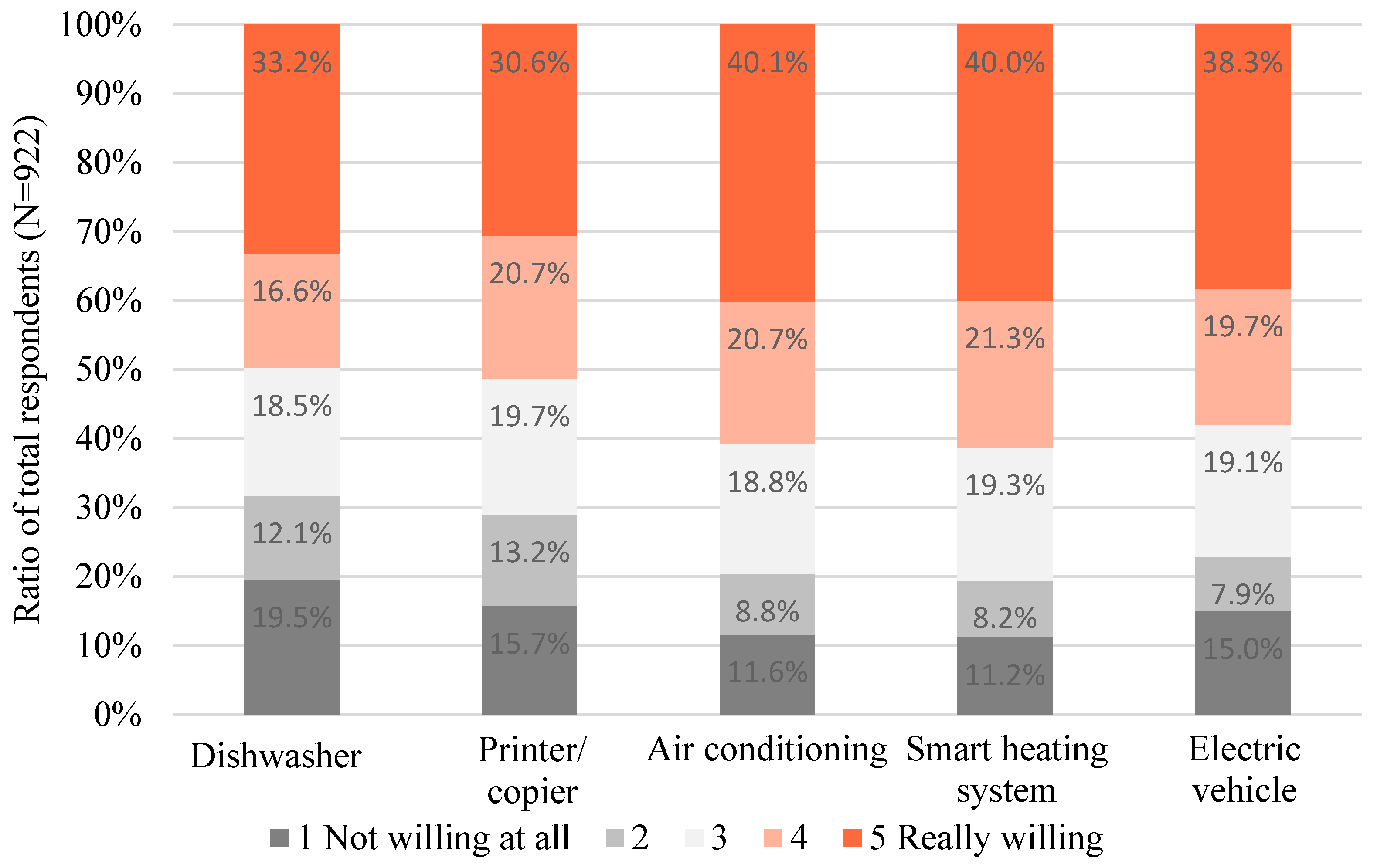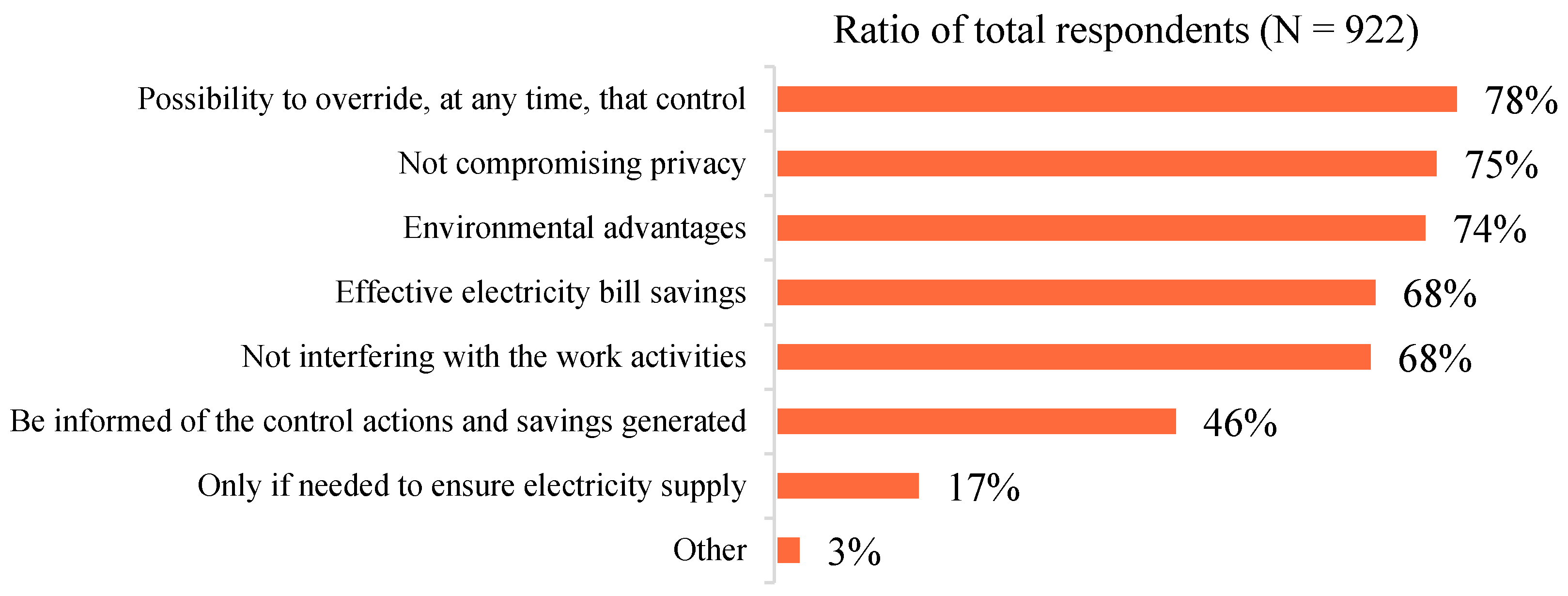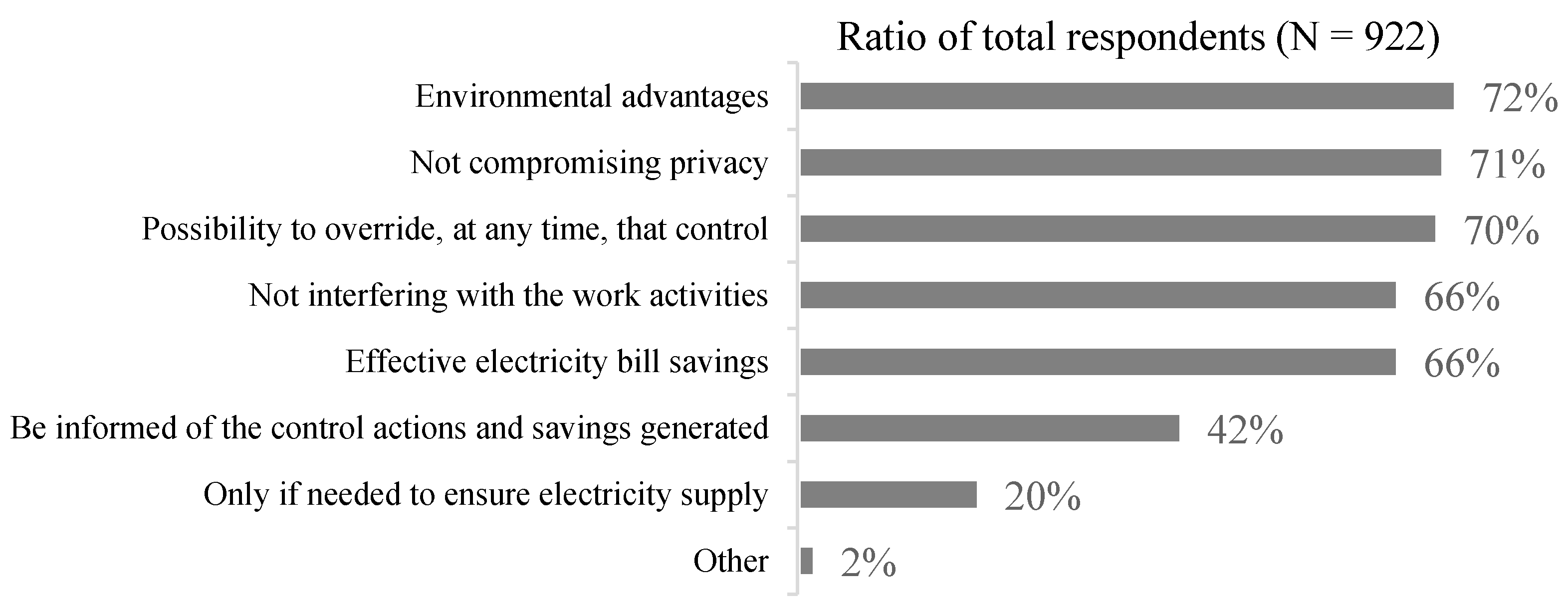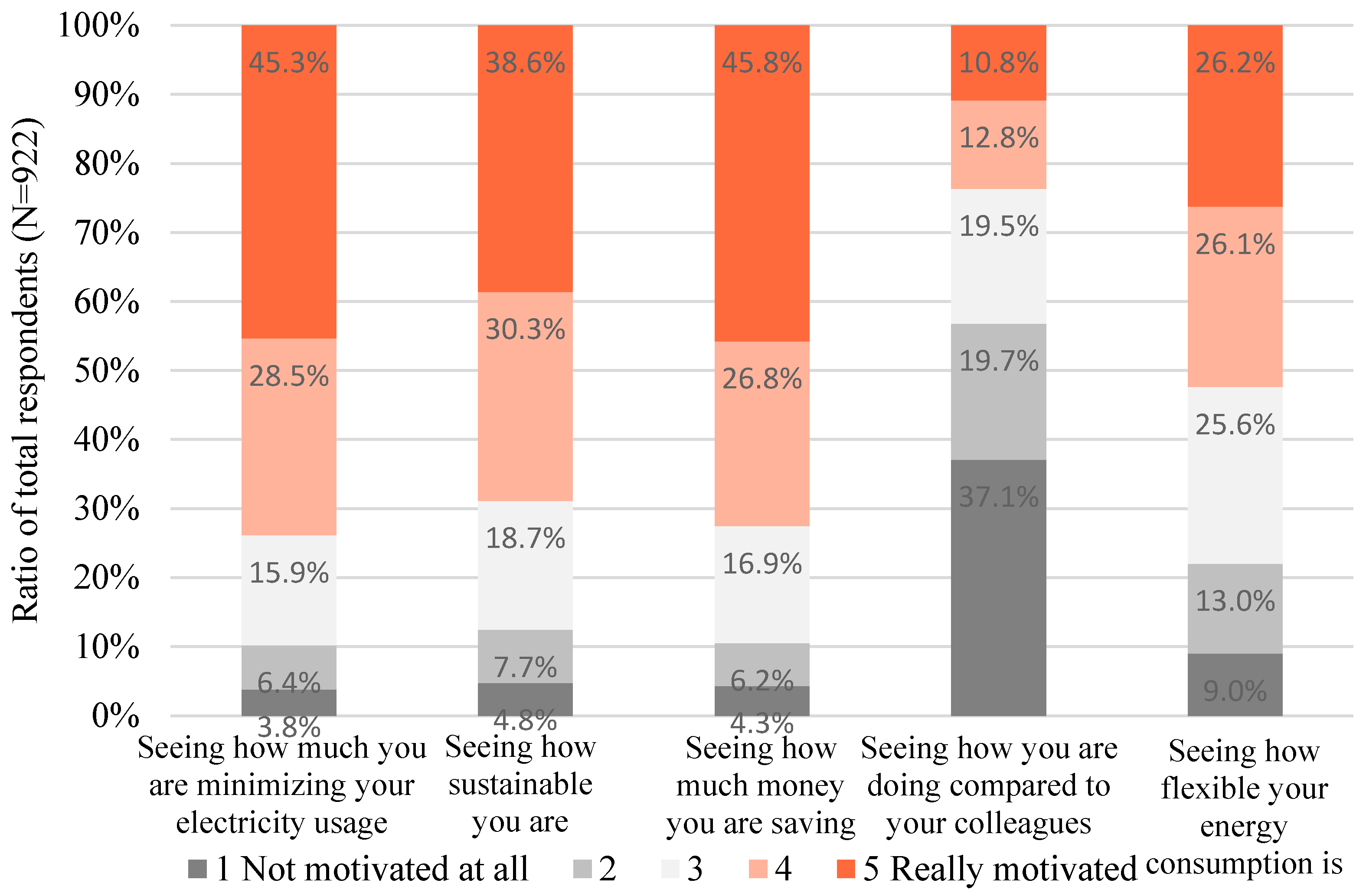Office Occupants’ Perspective Dealing with Energy Flexibility: A Large-Scale Survey in the Province of Bolzano
Abstract
1. Introduction
2. Materials and Methods
2.1. Questionnaire Design
2.2. Survey and Response
2.3. Data Analysis
3. Results and Discussion
3.1. Socio-Demographic Characteristics
3.2. Desires and Belifes about Renewable Energy Usage
3.3. User Perspectives on Smart Grid Technologies
3.4. Willingness to Use Smart Appliances in the Office
3.5. Motivation to Accept a Flexible Energy Usage
- -
- Privacy issues and interference with users’ activities were mentioned as main barriers to accept automatic control and smart grid technologies [56];
- -
- -
- -
- For the motivation ‘seeing how sustainable you are’:
- Gender (Z = −2.79, p = 0.005), females (MR = 480.08) were more motivated than males (MR = 432.22);
- Educational level (Z = 2.94, p = 0.003), respondents with ‘University/PhD’ title (MR = 488.92) were more motivated than people with ‘high school or lower’ level (MR = 439.54).
- -
- For the motivation ‘seeing how much money you are saving’:
- Gender (Z = −2.77, p = 0.006), females (MR = 479.65) were more motivated than males (MR = 432.90).
- -
- For the motivation ‘seeing how you are doing compared to your colleagues’:
- Age (K-W H = 13.75, p = 0.008), motivation (expressed in mean rank) was decreasing among age levels as follows: respondents’ age <30 (MR = 604.71), respondents’ age > = 60 (MR = 484.41), respondents’ age 50–59 (MR = 460.80), respondents’ age 30–39 (MR = 451.71), respondents’ age 40–49 (MR = 446.38).
4. Conclusions
- It is necessary to boost office end-user’s awareness towards the smart grid concept;
- High educational levels and high information on renewables may positively lead to higher experience with smart grids;
- Research on office end-user’s preferences about control options for smart appliances should be investigated in the future development of smart technologies;
- The privacy issue can represent an important barrier in the control of smart appliances, thus adequate information about cyber security must be provided to future ‘energy flexible end-users’;
- Economic savings and the reduction in energy consumption are important motivating factors to adopt smart technologies, and can be shown as valuable information on building energy displays and considered into smart grid business development.
Author Contributions
Funding
Acknowledgments
Conflicts of Interest
References
- UN-Environment. Global Environment Outlook—GEO-6: Healthy Planet, Healthy People; University Printing House: Cambridge, UK, 2019; ISBN 978-1-108-70766-4. [Google Scholar]
- European Commission. Clean Energy for All Europeans—Unlocking Europe’s Growth Potential. Available online: https://ec.europa.eu/commission/presscorner/detail/en/IP_16_4009 (accessed on 20 October 2019).
- European Commission. COM (2019) 640 final. Communication from the Commission to the European Parliament, European Council, the Council, the European Economic and Social Committee and the Committee of the Regions; The European Green Deal: Brussels, Belgium, 2019. [Google Scholar]
- van Hout, M.; Koutstaal, P.; Ozdemir, O.; Seebregts, A. Quantifying Flexibility Markets; ECN Policy Studies: Petten, The Netherlands, 2014; ECN-E-14-039. [Google Scholar]
- Altmann, M.; Brenninkmeijer, A.; Lanoix, J.; Ellison, D.; Crisan, A.; Hugyecz, A.; Koreneff, G.; Hänninen, S. Decentralized Energy Systems. Available online: https://www.europarl.europa.eu/document/activities/cont/201106/20110629ATT22897/20110629ATT22897EN.pdf (accessed on 12 November 2019).
- Colombo, E.; Bologna, S.; Masera, G. Renewable Energy for Unleashing Sustainable Development; Springer International Publishing: Cham, Switzerland, 2013; ISBN 978-3-319-00283-5. [Google Scholar]
- Jensen, S.O.; Marszal-Pomianowska, A.; Lollini, R.; Pasut, W.; Knotzer, A.; Engelmann, P.; Stafford, A.; Reynders, G. IEA EBC Annex 67 Energy Flexible Buildings. Energy Build. 2017, 155, 24–34. [Google Scholar] [CrossRef]
- Denholm, P.; Hand, M. Grid flexibility and storage required to achieve very high penetration of variable renewable electricity. Energy Policy 2011, 39, 1817–1830. [Google Scholar] [CrossRef]
- Moslehi, K.; Kumar, R. A reliability perspective of the smart grid. IEEE Trans. Smart Grid 2010, 1, 57–64. [Google Scholar] [CrossRef]
- Lund, P.D.; Lindgren, J.; Mikkola, J.; Salpakari, J. Review of energy system flexibility measures to enable high levels of variable renewable electricity. Renew. Sustain. Energy Rev. 2015, 45, 785–807. [Google Scholar] [CrossRef]
- Jensen, S.Ø.; Madsen, H.; Lopes, R.; Junker, R.G.; Aelenei, D.; Li, R.; Metzger, S.; Lindberg, K.B.; Marszal, A.J.; Kummert, M.; et al. Annex 67: Energy Flexible Buildings—Energy Flexibility as a Key Asset in a Smart Building Future. Available online: http://annex67.org/media/1470/position-paper-energy-flexibility-as-a-key-asset-i-a-smart-building-future.pdf (accessed on 22 January 2020).
- EU. Directive (EU) 2018/844 of the European Parliament and of the Council of 30 May 2018 Amending Directive 2010/31/EU on the Energy Performance of Buildings Directive 2012/27/EU on Energy Efficiency. Off. J. Eur. Union 2018, 19, L156/75–L156/91. [Google Scholar]
- Mlecnik, E.; Parker, J.; Ma, Z.; Corchero, C.; Knotzer, A.; Pernetti, R. Policy challenges for the development of energy flexibility services. Energy Policy 2020, 137, 111–147. [Google Scholar] [CrossRef]
- Wohlfarth, K.; Worrell, E.; Eichhammer, W. Energy efficiency and demand response—Two sides of the same coin? Energy Policy 2020, 137, 111070. [Google Scholar] [CrossRef]
- Lizana, J.; Chacartegui, R.; Barrios-Padura, A.; Valverde, J. Advances in thermal energy storage materials and their applications towards zero energy buildings: A critical review. Appl. Energy 2017, 203, 219–239. [Google Scholar] [CrossRef]
- Arteconi, A.; Hewitt, N.; Polonara, F. State of the art of thermal storage for demand-side management. Appl. Energy 2012, 93, 371–389. [Google Scholar] [CrossRef]
- Marszal, A.J.; Heiselberg, P. Household electricity demand profiles-A high-resolution load model to facilitate modelling of energy flexible buildings. Energy 2016, 103, 487–501. [Google Scholar] [CrossRef]
- Mohsenian-Rad, A.H.; Wong, V.W.; Jatskevich, J.; Schober, R.; Leon-Garcia, A. Autonomous demand-side management based on game-theoretic energy consumption scheduling for the future smart grid. IEEE Trans. Smart Grid 2010, 1, 320–331. [Google Scholar] [CrossRef]
- Clement-Nyns, K.; Haesen, E.; Driesen, J. The impact of charging plug-in hybrid electric vehicles on a residential distribution grid. IEEE Trans. Power Syst. 2010, 25, 371–380. [Google Scholar] [CrossRef]
- Evens, S.K.; Kärkkäinen, S. Pricing Models and Mechanisms for the Promotion of Demand Side Integration. Available online: http://www.ece.hut.fi/enete/Pricong_models.pdf (accessed on 12 January 2020).
- De Coninck, R.; Baetens, R.; Saelens, D.; Woyte, A.; Helsen, L. Rule-based demand-side management of domestic hot water production with heat pumps in zero energy neighbourhoods. J. Build. Perform. Simul. 2013, 7, 271–288. [Google Scholar] [CrossRef]
- Zhang, Y.; Campana, P.E.; Yang, Y.; Stridh, B.; Lundblad, A.; Yan, J. Energy flexibility from the consumer: Integrating local electricity and heat supplies in a building. Appl. Energy 2018, 223, 430–442. [Google Scholar] [CrossRef]
- Solomon, A.A.; Child, M.; Caldera, U.; Breyer, C. How much energy storage is needed to incorporate very large intermittent renewables? Energy Procedia 2017, 135, 283–293. [Google Scholar] [CrossRef]
- O’Connell, N.; Pinson, P.; Madsen, H.; O’Malley, M. Benefits and challenges of electrical demand response: A critical review. Renew. Sustain. Energy Rev. 2014, 39, 686–699. [Google Scholar] [CrossRef]
- Mourik-Duneworks, R. Business Models for a More Effective Market Uptake of DSM Energy Services: IEA DSM TCP Task 25. Available online: http://www.ieadsm.org/wp/files/%E2%88%9A-S1.2_Ruth_Mourik_Task_25.pdf (accessed on 4 February 2020).
- Li, R.; Pernetti, R.; Vigna, I.; Ma, T.; Knotzer, A.; Petersen, S.; Hedegaard, R.; Pedersen, T.; Schultz, M.J.; Korsgaard, J.; et al. Stakeholders’ Perceptive on Energy Flexible Buildings; DTU: Copenhagen, Denmark, 2017; ISBN 978-87-93250-xx-7. [Google Scholar]
- Le Dréau, J.; Heiselberg, P. Energy flexibility of residential buildings using short term heat storage in the thermal mass. Energy 2016, 111, 991–1002. [Google Scholar] [CrossRef]
- Shove, E. Energy and social practice: From abstractions to dynamic processes. In Complex Systems and Social Practices in Energy Transitions; Labanca, N., Ed.; Springer International Publishing: Cham, Switzerland, 2017; ISBN 978-3-319-33752-4. [Google Scholar]
- Shove, E.; Walker, G. Governing transitions in the sustainability of everyday life. Res. Policy 2010, 39, 471–476. [Google Scholar] [CrossRef]
- Darby, S.J.; McKenna, E. Social implications of residential demand response in cool temperate climates. Energy Policy 2012, 49, 759–769. [Google Scholar] [CrossRef]
- Paetz, A.; Dütschke, E.; Fichtner, W. Smart Homes as a Means to Sustainable Energy Consumption: A Study of Consumer Perceptions. J. Consum. Policy 2012, 35, 23–41. [Google Scholar] [CrossRef]
- Verbong, G.; Beemsterboer, S.; Sengers, F. Smart grids or smart users? Involving users in developing a low carbon electricity economy. Energy Policy 2013, 52, 117–125. [Google Scholar] [CrossRef]
- Ma, Z.; Billanes, D.; Nørregaard Jørgensen, B. User Needs, Motivation and Barriers for Application of Energy Flexibility in Buildings. Available online: http://www.annex67.org/media/1550/user-needs-motivation-and-barriers-for-application-of-energy-flexibility-in-buildings.pdf (accessed on 17 March 2020).
- Li, R.; Dane, G.; Finck, C.; Zeiler, W. Are building users prepared for energy flexible buildings?—A large-scale survey in the Netherlands. Appl. Energy 2017, 203, 623–634. [Google Scholar] [CrossRef]
- Billanes, J.; Ma, Z.; Jørgensen, B. Consumer Central Energy Flexibility in Office buildings. J. Energy Power Eng. 2017, 11, 621–630. [Google Scholar]
- Balest, J.; Pisani, E.; Vettorato, D.; Secco, L. Local reflections on low-carbon energy systems: A systematic review of actors, processes, and networks of local societies. Energy Res. Soc. Sci. 2018, 42, 170–181. [Google Scholar] [CrossRef]
- Pallonetto, F.; De Rosa, M.; D’Ettorre, F.; Finn, D.P. On the assessment and control optimisation of demand response programs in residential buildings. Renew. Sust. Energy Rev. 2020, 127, 109861. [Google Scholar] [CrossRef]
- Lichbach, M.I.; Zuckerman, A.S. Comparative Politics: Rationality, Culture, and Structure, 2nd ed.; Cambridge University Press: New York, NY, USA, 2009; ISBN 978-0-521-88515-7. [Google Scholar]
- Samad, T.; Koch, E.; Stluka, P. Automated demand response for smart buildings and microgrids: The state of the practice and research challenges. Proc. IEEE 2016, 104, 726–744. [Google Scholar] [CrossRef]
- Aduda, K.O.; Labeodan, T.; Zeiler, W. Towards critical performance considerations for using office buildings as a power flexibility resource—A survey. Energy Build. 2018, 159, 164–178. [Google Scholar] [CrossRef]
- Hargreaves, T.; Nye, M.; Burgess, J. A qualitative field study of how householders interact with feedback from smart energy monitors. Energy Policy 2011, 38, 6111–6119. [Google Scholar] [CrossRef]
- Blasch, J.; Boogen, N.; Daminato, C.; Filippini, M. Empower the consumer! Energy-related financial literacy and its socioeconomic determinants. CER-ETH Work. Paper 2018, 18, 289. [Google Scholar]
- Pettersen, I.N.; Verhulst, E.; Kinloch, R.V.; Junghans, A.; Berker, T. Ambitions at work: Professional practices and the energy performance of non-residential buildings in Norway. Energy Res. Soc. Sci. 2017, 32, 112–120. [Google Scholar] [CrossRef]
- Sintov, N.D.; White, L.V.; Walpole, H. Thermostat wars? The roles of gender and thermal comfort negotiations in household energy use behavior. PLoS ONE 2019, 14, e0224198. [Google Scholar] [CrossRef] [PubMed]
- Della Valle, N.; Bisello, A.; Balest, J. In search of behavioural and social levers for effective social housing retrofit programs. Energy Build. 2018, 172, 517–524. [Google Scholar] [CrossRef]
- Li, J.; Zhang, J.; Zhang, D.; Ji, Q. Does gender inequality affect household green consumption behaviour in China? Energy Policy 2019, 135, 111071. [Google Scholar] [CrossRef]
- Outcault, S.; Sanguinetti, A.; Pritoni, M. Using social dynamics to explain uptake in energy saving measures: Lessons from space conditioning interventions in Japan and California. Energy Res. Soc. Sci. 2018, 45, 276–286. [Google Scholar] [CrossRef]
- Staddon, S.C.; Cycil, C.; Goulden, M.; Leygue, C.; Spence, A. Intervening to change behaviour and save energy in the workplace: A systematic review of available evidence. Energy Res. Soc. Sci. 2016, 17, 30–51. [Google Scholar] [CrossRef]
- EU Commission. DG Energy. European Smart Metering Benchmark. Available online: https://www.vert.lt/SiteAssets/teises-aktai/EU28%20Smart%20Metering%20Benchmark%20Revised%20Final%20Report.pdf (accessed on 2 August 2020).
- Vigna, I.; Pernetti, R.; Pernigotto, G.; Gasparella, A. Analysis of the building smart readiness indicator calculation: A comparative case-study with two panels of experts. Energies 2020, 13, 2796. [Google Scholar] [CrossRef]
- Sinfonia—Low Carbon Cities for Better Living. Documents from Bolzano. Available online: http://www.sinfonia-smartcities.eu/en/demo-city/bolzano/demonstration-buildings/ (accessed on 2 August 2020).
- EU FESR—INTEGRIDS: Studio Dell’integrazione Di Reti Elettriche E Termiche Con La Flessibilità Energetica Degli Edifici. Available online: http://www.eurac.edu/en/research/technologies/renewableenergy/projects/Pages/EU-FESR---INTEGRIDS.aspx (accessed on 2 August 2020).
- Amministrazione Provincia Bolzano. Energy Report. 2015. Available online: http://www.provincia.bz.it/amministrazione/patrimonio/energy-report.asp (accessed on 2 August 2020).
- Corbetta, P. Social Research: Theory, Methods and Techniques; SAGE Publications Ltd.: London, UK, 2003; ISBN 978-0-761-97252-5. [Google Scholar]
- International Energy Agency. Technology Roadmap Smart Grids. Available online: https://webstore.iea.org/technology-roadmap-smart-grids (accessed on 6 March 2020).
- Wilson, C.; Hargreaves, T.; Hauxwell-Baldw, R. Smart homes and their users: A systematic analysis and key challenges. Pers. Ubiquitous Comput. 2015, 19, 463–476. [Google Scholar] [CrossRef]
- Kobus, C.; Klaassen, E.; Mugge, R.; Schoormans, J. A real-life assessment on the effect of smart appliances for shifting households’ electricity demand. Appl. Energy 2015, 147, 335–343. [Google Scholar] [CrossRef]
- Giordano, V.; Meletiou, A.; Covrig, C.; Mengolini, A.; Ardelean, M.; Fulli, G. Smart Grid Projects in Europe: Lessons Learned and Current Developments; Publication Office of the European Union: Luxembourg, 2011; ISBN 978-92-79-20487-6. [Google Scholar]
- Gangale, F.; Mengolini, A.; Onyeji, I. Consumer engagement: An insight from smart grid projects in Europe. Energy Policy 2013, 60, 621–628. [Google Scholar] [CrossRef]
- Toft, M.; Schuitema, G.; Thogersen, J. Responsible technology acceptance: Model development and application to consumer acceptance of Smart Grid technology. Appl. Energy 2014, 134, 392–400. [Google Scholar] [CrossRef]
- Krishnamurti, T.; Schwartz, D.; Davis, A.; Fischhoff, B.; de Bruin, W.; Lave, L.; Wang, J. Preparing for smart grid technologies: A behavioral decision research approach to understanding consumer expectations about smart meters. Energy Policy 2012, 41, 790–797. [Google Scholar] [CrossRef]












| Survey Section | Questions |
|---|---|
| Socio-demographic characteristics | Gender, age, education level (high school or lower, university/PhD), position (employee, manager, team leader, team member, other), office typology (single office, shared office with another colleague, shared office with two other colleagues, shared office with three or more other colleagues, open space, other). |
| Beliefs and desires about renewable energy usage | Information on renewable energy sources Do you know about renewable energy sources? (no, a little bit, yes). Importance of using renewable energy How important, do you think, is using renewable energy instead of fossil fuels? (1 not at all important–5 very important); How important, do you think, is using renewable energy in your office? (1 not at all important–5 very important). |
| User perspectives about smart grids, smart appliances and smart meters | Experience with smart grid technologies How familiar were you with the smart grid concept or technologies before this questionnaire? (1 I didn’t know about it–5 I already knew a lot about it). Willingness or desire to use smart appliances in the office Would you be willing to let the following smart appliances be remotely controlled by your electricity utility?—dishwasher, printer/copier (ensuring urgent jobs will be done right away), air conditioning system (ensuring comfort temperature), smart heating system (ensuring comfort temperature), electric vehicle—(1 not willing at all–5 really willing); Would you be willing to follow the messages shown on your office energy display or your smart phone to manually turn on the following smart appliances at the recommended time?—dishwasher, printer/copier (ensuring urgent jobs will be done right away), air conditioning system (ensuring comfort temperature), smart heating system (ensuring comfort temperature), electric vehicle—(1 not willing at all–5 really willing). Motivation to accept a flexible energy usage What would be the conditions for you to ACCEPT the direct control of some appliances by your electricity utility? Choose as many as apply. -not compromising privacy, possibility to override at any time that control, not interfering with the work activities, only if needed to ensure electricity supply, environmental advantages, effective electricity bill savings, be informed of the control actions and savings generated, other-; What would be the conditions for you to FOLLOW the recommendations form your electricity utility and manual control your appliances? Choose as many as apply. -not compromising privacy, possibility to override at any time that control, not interfering with the work activities, only if needed to ensure electricity supply, environmental advantages, effective electricity bill savings, be informed of the control actions and savings generated, other-; What would be the reason for you to NOT ACCEPT the control of some appliances by your electricity utility? Choose as many as apply. -interference with privacy, no override function, risk of inference with the work activities, mistrust in the electricity utility, unawareness on the motive requiring that action, risk of damaging equipment, lack of contractual legitimacy, unawareness on the control actions, might be too complex to operate, other-; What would be the reason for you to NOT FOLLOW the recommendations from your electricity utility? Choose as many as apply. -interference with privacy, no override function, risk of inference with the work activities, mistrust in the electricity utility, unawareness on the motive requiring that action, risk of damaging equipment, lack of contractual legitimacy, unawareness on the control actions, might be too complex to operate, other-; How motivating do you think you will be from the following things?—seeing how much you are minimizing your electricity usage, seeing how sustainable you are, seeing how much money you are saving, seeing how you are doing compared to your colleagues, seeing how flexible your energy consumption is—(1 not motivated at all–5 really motivated); What information would you want to see on your building energy display? Choose as many as apply. -the amount of CO2 reduction, the amount of saved money, the amount of saved energy, the influence of your energy usage on the environment, other- How do you think smart grids will influence your work? (1 in a bad way–5 in a good way). |
| Characteristics | Categories | Survey Answers (%) |
|---|---|---|
| Gender | Male | 39 |
| Female | 61 | |
| Age (years old) | <30 | 4 |
| 30–39 | 17 | |
| 40–49 | 37 | |
| 50–59 | 35 | |
| ≥60 | 7 | |
| Educational level | High school or lower | 56 |
| University/PhD | 44 | |
| Position | Employee | 77 |
| Manager | 13 | |
| Team leader | 6 | |
| Team member | 2 | |
| Other | 2 | |
| Office typology | Single office | 42 |
| Shared office with another colleague | 40 | |
| Shared office with two other colleagues | 7 | |
| Shared office with 3 or more other colleagues | 6 | |
| Open space | 2 | |
| Other | 2 |
© 2020 by the authors. Licensee MDPI, Basel, Switzerland. This article is an open access article distributed under the terms and conditions of the Creative Commons Attribution (CC BY) license (http://creativecommons.org/licenses/by/4.0/).
Share and Cite
Vigna, I.; Balest, J.; Pasut, W.; Pernetti, R. Office Occupants’ Perspective Dealing with Energy Flexibility: A Large-Scale Survey in the Province of Bolzano. Energies 2020, 13, 4312. https://doi.org/10.3390/en13174312
Vigna I, Balest J, Pasut W, Pernetti R. Office Occupants’ Perspective Dealing with Energy Flexibility: A Large-Scale Survey in the Province of Bolzano. Energies. 2020; 13(17):4312. https://doi.org/10.3390/en13174312
Chicago/Turabian StyleVigna, Ilaria, Jessica Balest, Wilmer Pasut, and Roberta Pernetti. 2020. "Office Occupants’ Perspective Dealing with Energy Flexibility: A Large-Scale Survey in the Province of Bolzano" Energies 13, no. 17: 4312. https://doi.org/10.3390/en13174312
APA StyleVigna, I., Balest, J., Pasut, W., & Pernetti, R. (2020). Office Occupants’ Perspective Dealing with Energy Flexibility: A Large-Scale Survey in the Province of Bolzano. Energies, 13(17), 4312. https://doi.org/10.3390/en13174312





